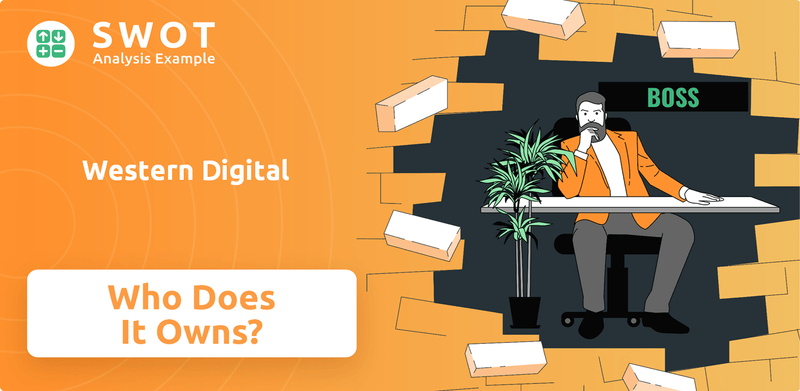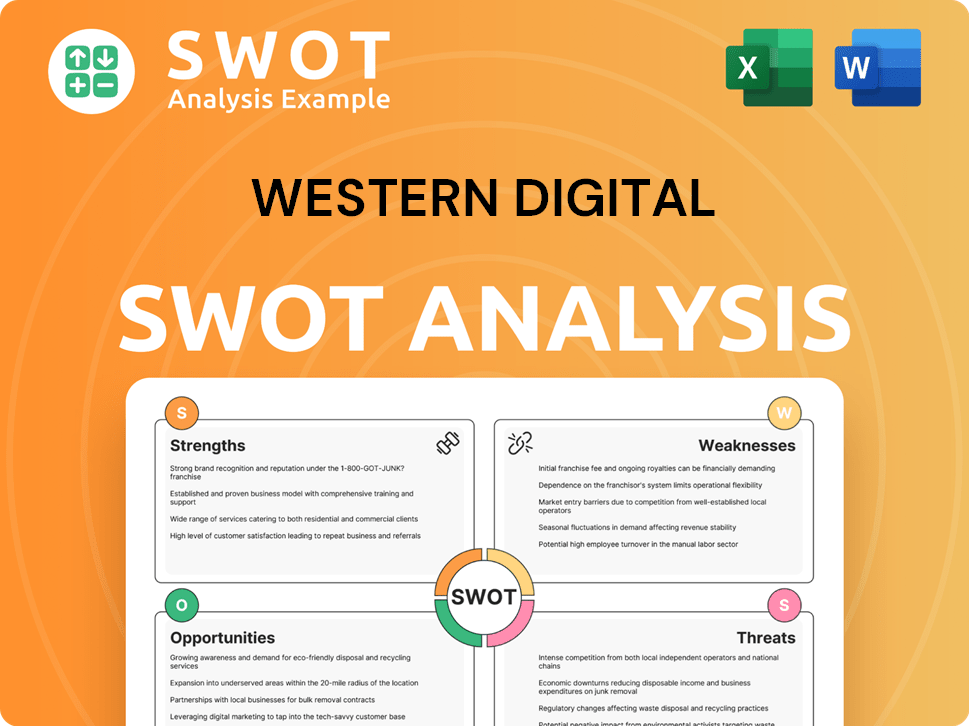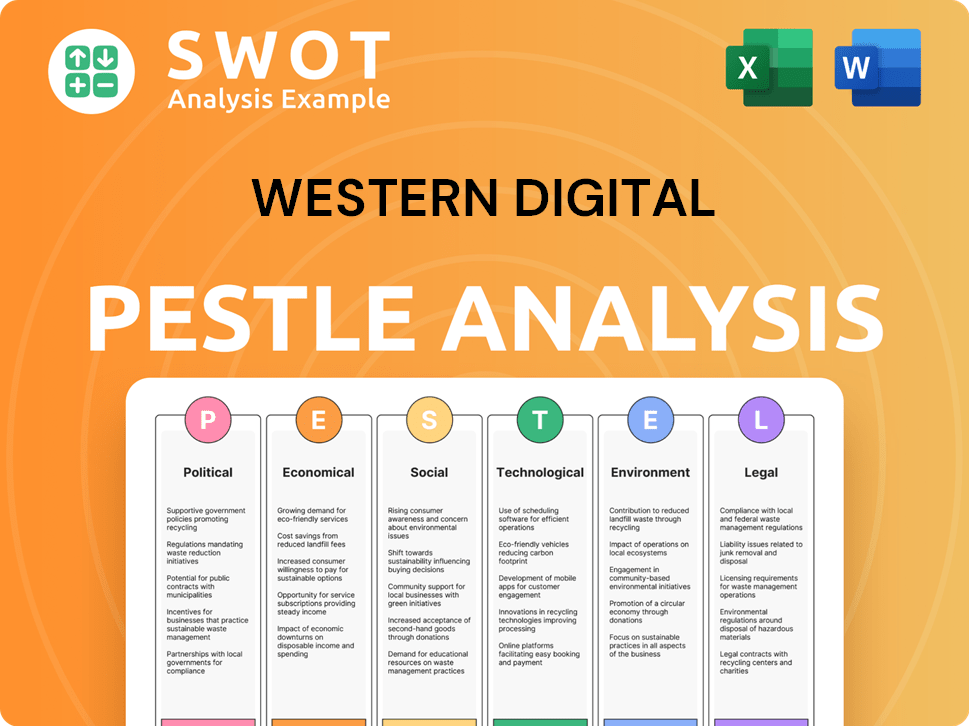Western Digital Bundle
Who Really Owns Western Digital?
Unraveling the Western Digital SWOT Analysis is just the beginning. Understanding the WD company owner and its ownership structure is crucial for anyone invested in the data storage industry. With the recent spin-off of SanDisk, the spotlight is firmly on Western Digital's future and the forces that shape it.

This deep dive into Western Digital ownership will explore the company's evolution, from its founding to its current status as a major player in hard disk drives. We'll examine the influence of its shareholders, the impact of its board of directors, and the strategic implications of the SanDisk spin-off. Discover the key stakeholders and understand the WD corporation's trajectory.
Who Founded Western Digital?
The story of Western Digital begins on April 23, 1970, when Alvin B. Phillips, formerly of Motorola, established the company. Initially named General Digital Corporation, the firm was based in Newport Beach, California, before relocating to Santa Ana, California.
Phillips, an ex-General Electric engineer, launched the venture with an initial capital investment of $10,000. The company's early focus was on manufacturing MOS semiconductor test equipment, later transitioning into a specialized semiconductor maker.
Early funding came from individual investors and the industrial conglomerate Emerson Electric. Around July 1971, the company adopted the name Western Digital Corporation and soon introduced its first product, the WD1402A UART.
Western Digital was founded by Alvin B. Phillips, a former Motorola employee. The company started as General Digital Corporation before becoming Western Digital.
Initially, the company focused on producing MOS semiconductor test equipment. It later shifted to become a specialty semiconductor maker.
Western Digital secured start-up capital from individual investors and Emerson Electric. Emerson Electric later withdrew its support.
The company changed its name to Western Digital Corporation around July 1971. This change marked a new phase in its development.
The first product introduced by Western Digital was the WD1402A UART. This marked its entry into the product market.
Western Digital declared Chapter 11 bankruptcy in 1976, and Chuck Missler became chairman and CEO in June 1977, becoming the largest shareholder during that period.
By 1975, Western Digital was the largest independent calculator chip maker globally, but faced challenges, including the mid-1970s oil crisis and the bankruptcy of a major customer. This led to Chapter 11 bankruptcy in 1976. The Competitors Landscape of Western Digital also played a role in the company's early struggles. Chuck Missler joined as chairman and chief executive in June 1977 and became the largest shareholder at the time.
- Alvin B. Phillips founded Western Digital.
- Early funding came from individual investors and Emerson Electric.
- The company declared Chapter 11 bankruptcy in 1976.
- Chuck Missler became the largest shareholder.
Western Digital SWOT Analysis
- Complete SWOT Breakdown
- Fully Customizable
- Editable in Excel & Word
- Professional Formatting
- Investor-Ready Format

How Has Western Digital’s Ownership Changed Over Time?
The ownership of the WD corporation is primarily structured around institutional investors, with a significant portion also held by public and individual investors. As a publicly traded company, listed on the Nasdaq under the ticker WDC, its ownership has evolved through strategic acquisitions and, most recently, a major corporate restructuring. Understanding the dynamics of who owns Western Digital is crucial for investors and stakeholders alike, as it reflects the company's strategic direction and market position.
Key events have significantly impacted the Western Digital ownership structure. The acquisition of Hitachi Global Storage Technologies (HGST) in 2012 expanded its market share in the HDD sector. The acquisition of SanDisk in May 2016 for US$19 billion marked a major move into the flash memory market. The most recent and transformative event was the spin-off of its flash memory business, completed on February 24, 2025, which created SanDisk Corporation (SNDK) as an independent public company. This separation, driven by activist investor Elliott Management, aimed to unlock shareholder value and reshape the company's focus.
| Ownership Category | Percentage of Shares | Notes |
|---|---|---|
| Institutional Investors | Approximately 78.61% | Includes firms like The Vanguard Group. |
| Insiders | Approximately 0.89% | Includes company executives and board members. |
| Public Companies and Individual Investors | Approximately 20.50% | Represents the remaining shares held by the public. |
The recent spin-off of the flash memory business into SanDisk Corporation (SNDK) has altered the ownership landscape. Following the spin-off, Western Digital Corporation (WDC) retains a 19.9% equity stake in SanDisk Corporation for up to 12 months. This strategic move is expected to allow both entities to focus on their respective markets and drive shareholder value. For more insights into the company's target market, consider exploring the Target Market of Western Digital.
Western Digital's ownership is primarily held by institutional investors, with a significant portion also held by public and individual investors.
- Institutional investors hold the majority of shares.
- The spin-off of the flash memory business created SanDisk Corporation.
- Western Digital retains a stake in SanDisk Corporation.
- Strategic acquisitions have shaped the company's evolution.
Western Digital PESTLE Analysis
- Covers All 6 PESTLE Categories
- No Research Needed – Save Hours of Work
- Built by Experts, Trusted by Consultants
- Instant Download, Ready to Use
- 100% Editable, Fully Customizable

Who Sits on Western Digital’s Board?
Following the SanDisk spin-off, the board of directors at Western Digital has seen significant changes. David Goeckeler, formerly CEO, transitioned to lead SanDisk Corporation, while Irving Tan became the CEO of the remaining HDD-focused Western Digital company, effective February 21, 2025. The board appointed Irving Tan, Bruce Kiddoo, and Roxanne Oulman to fill vacated positions, as detailed in the company's 8-K filing from January 30, 2025. These changes reflect strategic shifts aimed at enhancing shareholder value and adapting to market dynamics.
The current board composition includes a mix of individuals representing major shareholders, such as institutional investors, alongside independent directors. The spin-off was influenced by activist investor Elliott Management, highlighting the impact of significant stakeholders on decision-making. As a publicly traded company, Western Digital generally operates under a one-share-one-vote principle, where each share of common stock carries one vote, influencing the company's strategic direction and financial performance. For more insights, you can explore the Revenue Streams & Business Model of Western Digital.
| Board Member | Title | Notes |
|---|---|---|
| Irving Tan | CEO & Director | Assumed CEO role from February 2025. |
| Bruce Kiddoo | Director | Appointed to the board after the spin-off. |
| Roxanne Oulman | Director | Appointed to the board after the spin-off. |
The changes in leadership and board composition are part of Western Digital's response to market pressures and shareholder demands, aiming to streamline operations and focus on core business areas. The company's structure is designed to maximize shareholder value, with major shareholders holding significant influence through their voting power. The recent moves, including the spin-off, are aimed at improving the company's competitive position and financial performance in the evolving data storage market.
Western Digital's board and leadership have recently undergone significant changes, including the appointment of Irving Tan as CEO. The board includes a mix of institutional investors and independent directors. The company operates under a one-share-one-vote system.
- The SanDisk spin-off has reshaped the company's leadership.
- Shareholder influence, particularly from institutional investors, is significant.
- The company's structure is designed to enhance shareholder value.
- Activist investor influence plays a role in strategic decisions.
Western Digital Business Model Canvas
- Complete 9-Block Business Model Canvas
- Effortlessly Communicate Your Business Strategy
- Investor-Ready BMC Format
- 100% Editable and Customizable
- Clear and Structured Layout

What Recent Changes Have Shaped Western Digital’s Ownership Landscape?
Over the past few years, the ownership structure of Western Digital has seen significant shifts. A major development was the separation of its Flash business from its HDD business, which concluded on February 24, 2025. This strategic move, announced in October 2023, resulted in Western Digital becoming a pure-play hard disk drive manufacturer. The flash memory and SSD business now operates independently as SanDisk Corporation. This separation was intended to enhance operational focus and unlock shareholder value, as the market attributes different growth potentials to HDDs versus NAND Flash. This restructuring directly impacts the company's profile and its strategic direction.
Post-spin-off, Western Digital has initiated a $2.0 billion share repurchase program, authorized by its Board of Directors on May 13, 2025. This, along with the recently initiated quarterly dividend of $0.40 per share, is part of a shareholder-friendly capital allocation strategy, which includes reinvesting in the business and reducing debt. The company aims to return 100% of excess free cash flow to shareholders once its net leverage reaches 1x to 1.5x. This demonstrates a commitment to rewarding shareholders and managing its financial health. For more insights into the company's strategic direction, you can read about the Growth Strategy of Western Digital.
| Metric | Details | Date |
|---|---|---|
| Share Repurchase Program | $2.0 billion | Authorized May 13, 2025 |
| Quarterly Dividend | $0.40 per share | Initiated Recently |
| HDD Market Share (approx.) | Western Digital and Seagate each ~40% | Ongoing |
The HDD market is largely an oligopoly, with Western Digital and Seagate dominating. Western Digital anticipates a 23% compound annual growth rate (CAGR) in HDD exabyte shipments from 2024 to 2028. This growth is driven by organic cloud expansion (15% CAGR) and AI-related demands (8% CAGR). The company is also advancing its Heat-Assisted Magnetic Recording (HAMR) technology, with testing underway with two major hyperscale customers as of February 2025. These initiatives show the company's focus on innovation and its commitment to maintaining its market position.
Western Digital is a publicly traded company, with its shares available on major stock exchanges. The company's ownership structure is primarily composed of institutional investors and individual shareholders.
The company's financial strategy includes a $2.0 billion share repurchase program and a quarterly dividend. These initiatives are designed to enhance shareholder value and manage capital allocation effectively.
Western Digital holds a significant share of the HDD market, alongside Seagate. The company is focused on data center storage, anticipating strong growth in this segment.
The company is investing in advanced technologies like HAMR. It anticipates significant growth in HDD exabyte shipments, driven by cloud expansion and AI demands.
Western Digital Porter's Five Forces Analysis
- Covers All 5 Competitive Forces in Detail
- Structured for Consultants, Students, and Founders
- 100% Editable in Microsoft Word & Excel
- Instant Digital Download – Use Immediately
- Compatible with Mac & PC – Fully Unlocked

Related Blogs
- What are Mission Vision & Core Values of Western Digital Company?
- What is Competitive Landscape of Western Digital Company?
- What is Growth Strategy and Future Prospects of Western Digital Company?
- How Does Western Digital Company Work?
- What is Sales and Marketing Strategy of Western Digital Company?
- What is Brief History of Western Digital Company?
- What is Customer Demographics and Target Market of Western Digital Company?
Disclaimer
All information, articles, and product details provided on this website are for general informational and educational purposes only. We do not claim any ownership over, nor do we intend to infringe upon, any trademarks, copyrights, logos, brand names, or other intellectual property mentioned or depicted on this site. Such intellectual property remains the property of its respective owners, and any references here are made solely for identification or informational purposes, without implying any affiliation, endorsement, or partnership.
We make no representations or warranties, express or implied, regarding the accuracy, completeness, or suitability of any content or products presented. Nothing on this website should be construed as legal, tax, investment, financial, medical, or other professional advice. In addition, no part of this site—including articles or product references—constitutes a solicitation, recommendation, endorsement, advertisement, or offer to buy or sell any securities, franchises, or other financial instruments, particularly in jurisdictions where such activity would be unlawful.
All content is of a general nature and may not address the specific circumstances of any individual or entity. It is not a substitute for professional advice or services. Any actions you take based on the information provided here are strictly at your own risk. You accept full responsibility for any decisions or outcomes arising from your use of this website and agree to release us from any liability in connection with your use of, or reliance upon, the content or products found herein.